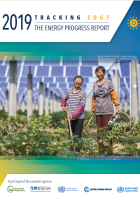Publications
Tracking SDG7: The Energy Progress Report 2019
- According to the latest data, the world is making progress towards achieving Sustainable Development Goal 7 (SDG 7) but will fall short of meeting the targets by 2030 at the current rate. The report shows that in recent years, pronounced progress in expanding access to electricity was made in several countries, but that those still lacking access are concentrated in Sub-Saharan Africa.
- In 2016, Africa and Asia still counted 3 billion as the population with no access to clean cooking solutions. Renewable Energy saw a 17.5% global total in energy consumption in the same year while energy efficiency, global intensity was registered at 5.1 megajoules pers U.S. dollar. Energy Efficiency improvements increased steadily in recent years thanks to concentrated policy efforts in major economies such as China. However, the global rate of improvement in primary energy intensity still lags behind SDG7.3, and estimates suggest that improvements slowed in years 2017 -2018.
- This report identifies best practices that have proven successful in recent years, as well as key approaches that policy makers may deploy in coming years. Recommendations applicable to all SDG 7 targets include recognizing the importance of political commitment and long-term energy planning, stepping up private financing, and supplying adequate incentives for the deployment of clean technology options.
- The Energy Progress Report chronicles progress toward Sustainable Development Goal (SDG) 7 at the global, regional, and country levels. It is a joint effort of the International Energy Agency (IEA), the International Renewable Energy Agency (IRENA), the United Nations Statistics Division (UNSD), the World Bank, and the World Health Organization (WHO), all appointed by the United Nations as global custodian agencies responsible for collecting and reporting data related to the energy targets of SDG 7.
- The Energy Progress Report reviews progress to 2017 for energy access and to 2016 for renewable energy and energy efficiency, against a baseline year of 2010. Its methodology is detailed at the end of each chapter.
Users also downloaded
